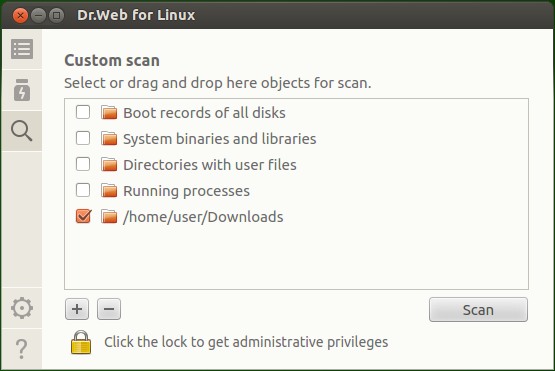In this section
•Editing the List of Custom Scan Objects
•Starting a Custom Scan of Listed Objects
Scanner can start the following scan types on user demand:
•Express scan—scan a strictly defined set of critical system objects that are at high risk to be compromised (boot records, system files and so on).
•Full scan—scan all local file system objects available to the user under whom Dr.Web Security Space is started.
•Custom scan—scan file system objects or some special-type objects directly specified by the user.
If Dr.Web Security Space operates in centralized protection mode and the centralized protection server does not allow the user to start file scanning, this page of the Dr.Web Security Space window is disabled.
Scanning increases processor load, which can cause the battery to discharge faster in case of running on mobile devices. Thus, it is recommended to perform a scan of a portable computer when it is plugged in. |
To start scanning of file system objects, click Scanner on the main page of the window.
The page with scan types opens. To start an Express or Full scan, click the corresponding button. After that, the scanning starts automatically.

Figure 8. Selection of a scan type
Scanning of objects is always performed by Scanner with current application privileges. If the application does not have elevated privileges, all files and directories that are inaccessible to the user who started Dr.Web Security Space will be skipped. To enable scanning of all required files that are not owned by you, elevate the application privileges before scanning (refer to the Managing Application Privileges section). |
To start the Custom scan of only required files and directories, do one of the following:
•Drag and drop
Open the page for selecting a scan type, drag the required files and directories using the mouse from a file manager window and drop them in the area marked with the Drag files here or click to select label. You can also drag the objects and drop them in the main page of the Dr.Web Security Space window.
When dragging files and directories to the window, it displays an area with the Drop files here label. To start scanning of the selected files, drop them in the page by releasing the mouse button. After that, the scanning will start automatically.

Figure 9. Area for adding files
•Adding objects for the custom scan
To select objects for the custom scan, click the area for adding files. A list of objects for the custom scan will be displayed on the screen.

Figure 10. List of objects for the custom scan
The list contains four special items denoting predefined groups of objects:
▫Boot records of all disks—all boot records of all available disks.
▫System binaries and libraries—all directories with system executable files (/bin, /sbin and so on).
▫Directories with user files—directories with user files and files of the current session (the /home/<username> home directory (~), /tmp, /var/mail, /var/tmp).
▫Running processes—executable files that started currently running processes. At that, if a threat is detected in an executable file, all processes started with it are forcibly terminated and the threat is neutralized.
Editing the List of Custom Scan Objects
If required, you can add custom paths to the list of the objects to be scanned. For that purpose, drag and drop required objects (paths to the objects are automatically added to the list) or click + below the list. After that, a standard dialog window opens, where you can select files and directories. Select a required object (a file or a directory) and click Open.
Click – below the list to remove all selected paths from the list (a path is selected if the list item containing this path is selected). To choose several paths, select items in the list and hold SHIFT or CTRL.
Hidden files and directories are not displayed in the file chooser by default. To view such objects, click
The first four items in the list are predefined and cannot be removed. |
Starting a Custom Scan of Listed Objects
To start a custom scan, select all check boxes for the objects to be scanned and click Scan. After that, the scanning starts.
After the scanning starts, the new task is added to the queue which contains all Scanner tasks of the current session: complete tasks, tasks in progress and pending tasks. You can view the list of tasks and manage them on the scan task management page.